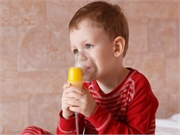- Navigating Your Midlife Crisis: Embracing New Possibilities
- City Raccoons Showing Signs of Domestication
- Mapping the Exposome: Science Broadens Focus to Environmental Disease Triggers
- One Week Less on Social Media Linked to Better Mental Health
- Your Brain Changes in Stages as You Age, Study Finds
- Some Suicide Victims Show No Typical Warning Signs, Study Finds
- ByHeart Formula Faces Lawsuits After Babies Sickened With Botulism
- Switch to Vegan Diet Could Cut Your Greenhouse Gas Emissions in Half
- Regular Bedtime Does Wonders for Blood Pressure
- Dining Alone Could Mean Worse Nutrition for Seniors
Air Pollution Tied to Asthma in Young Kids

High levels of air pollution may increase young children’s risk of developing asthma and persistent wheezing, researchers warn.
The findings “support emerging evidence that exposure to air pollution might influence the development of asthma,” according to a report by Torben Sigsgaard, of Aarhus University in Denmark, and colleagues.
For the new study, the researchers analyzed data on more than 797,000 Danish children who were born between 1997 and 2014 and followed from ages 1 year up to 15 years of age. Nearly 123,000 of the children developed asthma or persistent wheezing, just before age 2 on average.
The researchers then checked data on air pollution levels at the children’s home addresses, parents’ asthma, mothers’ smoking, parental education and income.
After accounting for other potentially influential factors, the investigators found higher levels of asthma and persistent wheezing in children of parents with asthma and in children of mothers who smoked during pregnancy.
Lower levels of asthma and persistent wheezing were found in children of parents with high levels of education and high incomes.
The researchers also found that children exposed to higher levels of fine particulate air pollution (PM2.5) were more likely to develop asthma and wheezing than those who weren’t exposed.
In people with asthma, the airways become inflamed and produce extra mucus, which makes it difficult to breathe.
The study was published online Aug. 19 in the BMJ.
This was an observational study and can’t establish cause and effect. The findings need to be confirmed in future studies.
Still, the results suggest that further reductions in PM2.5 “might help to reduce the number of children who develop asthma and persistent wheezing in highly exposed populations,” the study authors said in a journal news release.
PM2.5 is emitted by various sources, including power plants, motor vehicles and domestic heating. The particles are about 3% or less of the diameter of a human hair and can get deep into the lungs, and some may even enter the circulatory system.
Previous research has linked short-term peak exposure to air pollution with worsening of asthma. But it hasn’t been clear how long-term exposure and the timing of exposure, or the role of air pollution combined with other factors, affects asthma risk.
More information
The American Lung Association has more on children and asthma.
Source: HealthDay
Copyright © 2025 HealthDay. All rights reserved.










